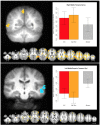Predicting Intentions of a Familiar Significant Other Beyond the Mirror Neuron System
- PMID: 28890691
- PMCID: PMC5574908
- DOI: 10.3389/fnbeh.2017.00155
Predicting Intentions of a Familiar Significant Other Beyond the Mirror Neuron System
Abstract
Inferring intentions of others is one of the most intriguing issues in interpersonal interaction. Theories of embodied cognition and simulation suggest that this mechanism takes place through a direct and automatic matching process that occurs between an observed action and past actions. This process occurs via the reactivation of past self-related sensorimotor experiences within the inferior frontoparietal network (including the mirror neuron system, MNS). The working model is that the anticipatory representations of others' behaviors require internal predictive models of actions formed from pre-established, shared representations between the observer and the actor. This model suggests that observers should be better at predicting intentions performed by a familiar actor, rather than a stranger. However, little is known about the modulations of the intention brain network as a function of the familiarity between the observer and the actor. Here, we combined functional magnetic resonance imaging (fMRI) with a behavioral intention inference task, in which participants were asked to predict intentions from three types of actors: A familiar actor (their significant other), themselves (another familiar actor), and a non-familiar actor (a stranger). Our results showed that the participants were better at inferring intentions performed by familiar actors than non-familiar actors and that this better performance was associated with greater activation within and beyond the inferior frontoparietal network i.e., in brain areas related to familiarity (e.g., precuneus). In addition, and in line with Hebbian principles of neural modulations, the more the participants reported being cognitively close to their partner, the less the brain areas associated with action self-other comparison (e.g., inferior parietal lobule), attention (e.g., superior parietal lobule), recollection (hippocampus), and pair bond (ventral tegmental area, VTA) were recruited, suggesting that the more a shared mental representation has been pre-established, the more neurons show suppression in their response to the presentation of information to which they are sensitive. These results suggest that the relation of performance to the extent of neural activation during intention understanding may display differential relationships based on the cognitive domain, brain region, and the cognitive interdependence between the observer and the actor.
Keywords: embodied cognition; fMRI; mirror neuron system; social neuroscience.
Figures




References
-
- Aron A., Aron E., Smollan D. (1992). Inclusion of other in the self-scale and the structure of interpersonal closeness. J. Pers. Soc. Psychol. 63, 596–612. 10.1037/0022-3514.63.4.596 - DOI
LinkOut - more resources
Full Text Sources
Other Literature Sources
Miscellaneous

